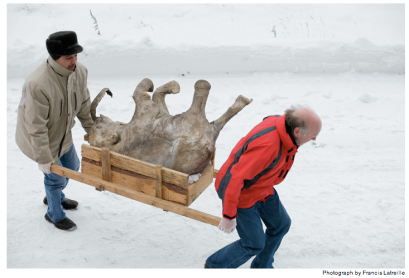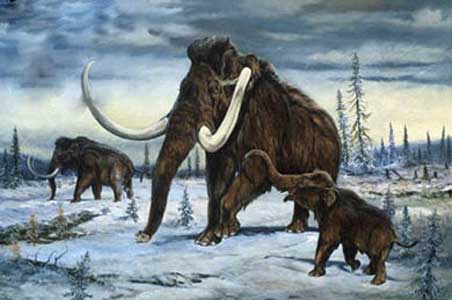Incertae Especie
Paleontology is the main subject debated in this blog.
domingo, 9 de septiembre de 2012
viernes, 27 de abril de 2012
lunes, 22 de febrero de 2010
First Dinosaur Fossil Discoveries
The first 3 dinosaur fossils led to the recognition of a new group of animals, the dinosaurs.
The first nearly-complete dinosaur skeleton in New Jersey spurs modern paleontology.
People have been finding dinosaur fossils for hundreds of years, probably even thousands of years. The Greeks and Romans may have found fossils, giving rise to their many ogre and griffin legends. There are references to "dragon" bones found in Wucheng, Sichuan, China (written by Chang Qu) over 2,000 years ago; these were probably dinosaur fossils.
Much later, in 1676, a huge thigh bone (femur) was found in England by Reverend Plot. It was thought that the bone belonged to a "giant," but was probably from a dinosaur. A report of this find was published by R. Brookes in 1763.
The First Dinosaur Fossil Scientifically Described
It was the first dinosaur ever described scientifically and first theropod dinosaur discovered (this is all in hindsight, because the dinosaurs had not yet been recognized as a separate taxonomic group - the word dinosaur hadn't even been invented yet).
The first dinosaur models (life size and made of concrete) were made by Benjamin Waterhouse Hawkins of England in 1854. The first dinosaur used for amusement was a life-size model of an Iguanodon (made by Hawkins) that was used to house a dinner party for scientists (including Richard Owen) at a major exhibition. The invitations to the party were sent on fake pterodactyl wings. The party took place in London, England, in 1854
Other Early Dinosaur Finds
IGUANODONGideon A. Mantell (1790-1852) was another early British fossil hunter. He described and named Iguanodon, a duck-billed plant-eater (1825); Iguanodon's teeth and a few bones were found in 1822, perhaps by his wife, Mrs. Mary Mantell in Sussex, (southern) England. Gideon Mantell also named Hylaeosaurus, an armored plant-eater (1833) , and others.
HYLAEOSAURUS
The Name "Dinosauria"
Sir Richard Owen (1804-1892) was a pioneering British comparative anatomist who coined the term dinosauria (from the Greek "deinos" meaning fearfully great, and "sauros" meaning lizard), recognizing them as a suborder of large, extinct reptiles in 1841.
He had noticed that a group of fossils (which included remains of Megalosaurus, Iguanodon, and Hylaeosaurus) had certain characteristics in common, including:
- Column-like legs
(instead of the sprawling legs
that other reptiles have)
- Five fused vertebrae fused to the pelvic girdle.
This new taxonomic name, Dinosauria, and new group of reptiles was only the beginning of a great scientific exploration. Since Owen's time, about 330 dinosaur genera have been described. Every few months (sometimes every few weeks), a new species is unearthed (for recent finds, see Dino News). Paleontologists have varying estimates of how many dinosaur genera existed during the Mesozoic Era; estimates range from about 1,000 to over 10,000. Whatever this number really is, there are a lot of new dinosaurs left to discover!
Etiquetas: Dinos
miércoles, 25 de noviembre de 2009
A Job
Asi que..ya tengo curro! no es algo super guay, como antes, pero es algo muy decente: soy profe de inglés en una escuela publica(catolica...como las mayorias de este país).
Empezé a dar clases sin tener una idea muy buena de como hacer esto..pero parece que me funciona. Claro que al principio estaba asustada y me portaba bién con los niños, sin mucha autoridad.
Por supuesto, que por esto he pagado bastante duro; un niñato ya me insulto, eso era inaguantable, tuvé que hacer algo, y la respuesta era ser más dura, autoritaria y estricta..parece que ahora funciona!
Gracias a Samu por sus ideas magnificas!
:)
jueves, 1 de octubre de 2009
Be who you are !
Estoy una más...una persona más sin trabajo! que decepión !
pero tengo esperanza, como cada persona debe tener. No ganas nada si desesperas...hay que tener confianza y todo saldrá bién..
Con lo mucho que me gustaba mirar y analizar las rocas, ahora muy poco puedo hacer, por lo menos no al microscopio...
Y de España no puedo esperar mucho, no creo que podré conseguir algun trabajo decente, por lo menos no en las siguentes semanas...pero, peroooo creo que saldré para adelante...confio en lo que afirmaban los Queen en uno de sus canciones: "Show must go on.."
So let´s get serious and when life gives you a hundred reasons to cry, show life that you have a thousand reasons to smile.
miércoles, 9 de septiembre de 2009
Little Liuba



A group of shepherds find a baby mammoth frozen in the shore of a river in Siberia.
When one of the shepherd was walking next to the river he saw a strange animal in the shore. The sheperds called the scientists and they took the animal to a museum. In the museum, they analized all the mammoth´s body and then they exhibited it for three days.
The animal is a female. She weighs about 100kg and measures 1 meter. She’s nearly complete, she just misses the fingernails and she has almost her whole hair.
Probably Liuba died drowned in the mud. The scientists have said that she fell into the quiksands, and she couldn’t escape.


Etiquetas: Mamut
En la época de transición entre el Plioceno y el Pleistoceno, los continentes se encontraban prácticamente en la misma posición que en la actualidad. Las placas tectónicas sobre las que reposan probablemente no se han movido mas de 100 Km en relación las unas con las otras desde los principios del pleistoceno.
El clima del pleistoceno se caracterizaba por ciclos glaciales repetidos en el que los glaciares continentales llegaban hasta el paralelo 40 en algunos puntos. Se calcula que durante el máximo glacial, el 30% de la superficie de la Tierra estaba cubierta de hielo. Además, una zona de permafrost se extendía hacía el sur desde el límite de la capa de hielo, unos pocos centenares de km en Norteamérica y mas lejos en Eurasia. La temperatura media anual en los límites del hielo era de -6º C; en el límite del permafrost, de 0º C.




